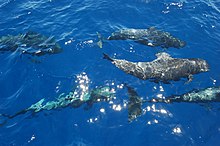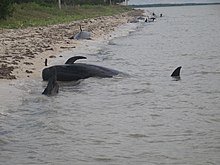Short-finned pilot whales can be confused with their relatives the long-finned pilot whales, but there are various differences. As their names indicate, their flippers are shorter than those of the long-finned pilot whale, with a gentler curve on the edge. They have fewer teeth than the long-finned pilot whale, with 14 to 18 on each jaw. Short-finned pilot whales are black or dark grey with a grey or white cape. They have grey or almost white patches on their bellies and throats and a grey or white stripe which goes diagonally upwards from behind each eye.
Adult males may have a number of scars on their bodies. Their heads are bulbous and this can become more defined in older males. Their dorsal fins vary in shape depending on how old the whale is and whether it is male or female. They have flukes with sharply pointed tips, a distinct notch in the middle and concave edges. They tend to be quite slender when they are young, becoming more stocky as they get older.
Physical characteristics
The short-finned whale has a stocky body, a bulbous forehead, no prominent beak, long flippers sharply pointed at the tip, black or dark grey color, and the dorsal fin set forward on body. The flukes are raised before a deep dive; they may float motionless at the surface, frequently are seen in very large groups, prefer deep water, and may be approached. Their diets are composed of fish, squid, and octopus.Adults males are about 5.5 meters (18 ft) in length, whereas adult females only reach about 3.7 meters (12 ft) in length. Adults can weigh from 1,000 to 3,000 kg (2200-6600 lbs) (1,000-3,000 kg). When they are born, short-finned pilot whales are about 1.4–1.9 m (4 ft 7 in–6 ft 3 in) long and weigh about 60 kg (130 lb). Males live nearly 45 years, whereas females can live up to 60 years[3] and go through menopause.[4]
Behavior
A short-finned pilot whale come up to the surface of the water.
Females mature at about 10 years of age and will start having calves every five to eight years. A female may nurse a calf for up to 15 years as long as it is the last born calf. Their gestation period lasts just over a year, and a female will have from four to six calves in her lifetime. A calf will suckle from its mother for a minimum of two years, but most will for nearly five years. A female will usually stop reproducing once reaching the age of about 40 years.[5]
The short-finned pilot whale primarily feeds on squid, but will also feed on certain species of fish and octopus. They feed at 300 m (980 ft) or more, and spend great lengths of time at depth.[citation needed] A pod may spread out up to 800 m (870 yd) to find food.[citation needed] They have also been reported to "harass" sperm whales and dolphins,[citation needed] so marine mammals could also potentially be part of their diets.
They are known as the 'cheetahs of the deep' for the high-speed pursuits of squid at depths of hundreds of metres.
Habitat
Short-finned pilot whales, unlike the related long-finned pilot whale, are found in most waters around the world. They primarily inhabit warm tropical waters, but usually stay offshore in the deeper waters. They also tend to be found in areas with a high density of squid. Known populations are found in the North Atlantic stretching all the way south to northern South America, including the Gulf of Mexico and to Africa, as well. They are thought to migrate south into the western North Atlantic in the late winter/early spring. Other populations are recorded throughout the entire Pacific stretching from Japan to southern Guatemala, as well as the Red Sea and Indian Ocean.The two distinct populations off the coasts of Japan have differences in their anatomy and genetics, and could potentially comprise more than one distinct species or subspecies. Their exact taxonomy has yet to be verified.[6]
At along the western coast of Tenerife, Canary Islands
Conservation
A number of beached short-finned pilot whales on Highland beach.
Cuisine

In a very few areas of Japan, mainly along the central Pacific coast, pilot whales are commercially hunted and the meat is available for human consumption. In certain restaurants or izakayas, pilot whale steaks are marinated, cut into small chunks, and grilled.[12] The meat is high in protein and low in fat (a whale's fat is contained in the layer of blubber beneath the skin).[12][13][14] When grilled, the meat is slightly flaky and quite flavorful, somewhat gamey, though similar to a quality cut of beef, but with distinct yet subtle undertones recalling its marine origin.[12][1

Range map





No comments:
Post a Comment
Note: Only a member of this blog may post a comment.